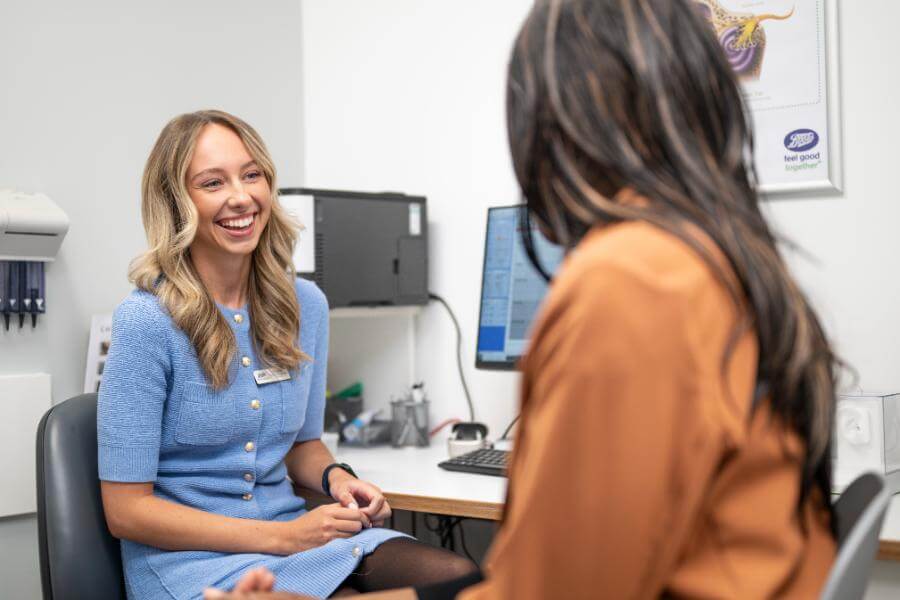How to insert a hearing aid for the first time
We’re here to help, if you’re worried about your hearing, book an appointment for a free hearing health check.

What can I expect in the first few weeks?
Depending on the severity of your hearing loss, your surroundings might sound muffled, or there might be certain sounds you’re missing. With a hearing aid, things will change abruptly. At first, everyday noises may sound surprisingly loud. Your own voice might sound strange, and even familiar noises might seem different.
Wearing a new hearing aid takes a bit of getting used to. Your ears need to get used to the sensation of wearing a hearing aid, and your brain suddenly has to start perceiving and processing many different sounds again. It might be a little while since you last heard the full range of sounds. Many of the background noises that people without hearing loss have learned to ignore will sound new to you, so to begin with, you’ll find them more tricky to shut out.
While you’re familiarising yourself with the new sounds around you, your brain will be relearning how to suppress background noise and focus on important sounds. But don’t worry – after a little while, you won’t even notice that you’re wearing a hearing aid.
What can I expect after that?
Give yourself time
Normally, you suppress unimportant background sounds, like the rustling of leaves or the tapping of keyboards in the office. But when you can’t hear these sounds, your brain forgets how to handle them. The sound-processing centres in your brain need to learn not only that everything sounds different with a hearing aid, but also that they need to filter out certain sounds again. This can take a little time.
Tip
To help your brain get used to normal ambient noise levels again, and to relearn how to ignore background noise, you should wear your hearing aids regularly. It’s important to not give up too soon. You might find it helpful to write down your experiences and problems in a hearing diary. This will help you track your progress and don’t forget that you can always contact your Boots Hearingcare expert for advice.
Familiarise yourself with how to handle your hearing aid
One important step in getting used to wearing your new hearing aids is to familiarise yourself with them. Your Hearing Aid Audiologist will explain how to insert and remove your hearing aids – make sure you practise this regularly. Learn how to look after your hearing aids properly, and how to maintain and clean them. Try out the different settings and listen to the differences.
Use your hearing aid at home
To begin with, use your hearing aids in a quiet setting. This will make it easier to pick out and understand individual sounds, without being distracted by noise from the street or conversations around you. It’s also a good idea to try to make your everyday environments as calm as possible.
Tip
You don’t need to wear your hearing aids all day to begin with. If the sounds become a bit too overwhelming, just take your hearing aids out and have a break. You can start by wearing them for a few hours each day, then increase the length of time gradually until you’re happy wearing them morning till evening.
Even a simple thing like an outdoor stroll can help you get used to your new hearing aids. In the open, you can concentrate on quiet outdoor sounds like the rustling of leaves, birds singing, or the splash of water in a stream, without distraction.
Gradually introduce the sound of TV and radio
When you have a quiet minute, try watching TV and listening to the radio with your hearing aids in. A good place to start is with the news. This is because newsreaders are trained to articulate clearly and there is very little background noise like music or sound effects that you might find on other shows.
Then, you could try phoning a loved one. Start with the volume turned down and adjust it during the call if you need to. Did you know that there are extra accessories available to help you get the best sound from your phone or TV, you can visit our shop to find out more.
Take the conversation challenge
It’s best if the first conversations you have wearing your hearing aids take place when you’re in a relaxed environment. We recommend that you talk to just one or two people, ideally somewhere with no background noise like the sound of a TV or household appliances. Why not explain to the people you’re talking to how hearing loss can affect communication, and how they can help you in conversations?
Try our useful tips for conversations where there’s more background noise:
• Choose the right place to stand. All hearing aids are designed to pick up the sounds you are facing so it’s best if the person you’re talking to is in front of you. If they’re sitting behind you or to your side, it might be trickier to understand them. Plus, if you’re face-to-face, you can make it easier by lip-reading too.
• If you’re having a conversation in a big group of people, you could remind them of simple things they can do to help you hear better, like speaking clearly and taking it in turns to talk. It might seem like the conversation moves very quickly, but don’t get frustrated if you’re finding it difficult to follow everything. You can always ask someone to sum up what’s been said.
• Keep an eye on your friends’ facial expressions and gestures – they’ll help you if you don’t catch a few words here and there. Most people with hearing loss are already used to doing this.
Loud environments
When you’re feeling more comfortable with your hearing aids, try wearing them in places with more background noise, like a busy street or restaurant.
How can my friends and family help?
It’s often your loved ones who encourage you to take the first step to hearing better, so they’ll be very happy to see you getting the help you need. Having your friends and family around you for support as you get used to hearing better is really valuable.
What to remember
Patience is really important – both for you, and your friends and family. Be patient with yourself, and remember that getting used to wearing your hearing aid doesn’t happen overnight. But your loved ones will be proud of you for getting help with your hearing, and you should be proud of yourself too – you’ve already come a long way!
Be honest
Being honest and open with the people you’re talking to is really important. Smiling and nodding when you actually can’t understand someone might end up making you both feel frustrated. If you can’t hear or you can’t understand, dont be afraid to say so!
Don’t feel embarrassed to ask people to speak more clearly, to paraphrase what they said or to ask them to look at you while they speak. These simple rules can be easy for people without hearing loss to forget. Plus, being honest about your own hearing might encourage other people to get help too.
Train your ears!
Just like any part of your body, there are exercises you can do to train your ears and help you get used to your hearing aids more quickly. Here are some different ones you can try...
Steps to practice on your ears



